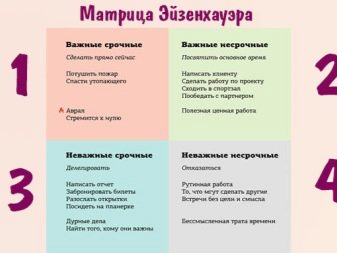In our insanely fast-paced century, time does not seem to just go, but flies at the speed of a supersonic plane. In such a cycle of events and days, loaded with a mass of affairs and plans, often we cannot realize even half of what was planned. And I want to catch everything. How to use time correctly, using the Eisenhower matrix, we will consider in more detail.
What it is?
Time is all that we have. For better or worse, we live our life directly depends on how and what we spend our time on. And those who want to have time to do a lot in their path, as a rule, learn to effectively manage their time. Time management (time management) is nothing more than planning. It is it that helps to stop worrying because of a bitter feeling that time is short, that it is sorely lacking, and because of this nothing can be done.
Once upon a time, the famous American military and political figure Dwight David Eisenhower was seriously engaged in finding a solution to the problem of effective planning, he was also the president of the United States. And he managed to find a solution to this problem, he even came up with his time management system.

The Eisenhower matrix is a tool for prioritizing business planning, a kind of technology for setting goals and objectives.
It just so happened that the human brain more easily and better perceives structured information, that is, brought into some specific system, broken down into shelves. At the same time, it would be nice to visualize these shelves, to make them visual, for example, using some kind of diagrams or diagrams.It is precisely this principle of distribution of cases that underlies the Eisenhower matrix, which is one of the leading methods in the theory of effective time management.
Visualization of the plan of actions and actions using the matrix is very simple. Draw a square on paper, divide it with two perpendicular lines into four equal fields. You should get a window with a grill in the form of a cross. These fields will break your case into 4 groups, each of which will depend on signs of importance / unimportance and urgency / non-urgency. The fields formed from the intersection of the lines are called quadrants (mathematical concept) and are denoted as follows:
- quadrant A (important and urgent tasks);
- quadrant B (important, but not urgent tasks);
- quadrant C (not important, but urgent tasks);
- quadrant D (unimportant and non-urgent tasks).


Advantages and disadvantages
The Eisenhower matrix has both advantages and disadvantages. We will describe both that and another, and we will begin with advantages.
- Despite its name “matrix”, which implies something complex, the system is actually very easy to understand and is applied without any difficulty.
- Cases, goals and objectives are divided into only 4 categories, this helps to better navigate them.
- The distribution of tasks according to the criteria of urgency and importance allows you to push non-urgent and unimportant matters into the background, thereby allowing you to move to the front important and urgent. This is how cases are analyzed and filtered. Those that do not need to waste time at all are eliminated.
- The main advantage is that the matrix allows you to make time costs as efficient as possible, which, in turn, makes it possible to do everything on time.
Disadvantages of this system are also available.
- The matrix is ineffective in long-term planning. It is suitable for current affairs or for the near future.
- When there are no daily goals, then there is no need to use such a system.
- To use the matrix effectively, you need to quickly and accurately distribute the goals into groups. To do this, you need to understand which of them can be assigned the degree of “important”, and which goals are not very important, which must be completed urgently, and which are optional. Such a training takes time, that is, the matrix does not “work” for you right away, but it’s a minus.
- And, as a result of the previous paragraph, there may be errors with the accuracy of assigning cases a certain status.
But, despite some shortcomings, the Eisenhower matrix is a highly effective time management tool.

Quadrant Characterization
We consider each quadrant of the matrix in more detail.
A (important and urgent tasks)
If you are a master in planning, then quadrant A will be empty. If things appeared in it, this indicates your poor organization. You allow education in the affairs of rummages and blockages. The reason for this picture is, as a rule, laziness.
Or you may not prioritize properly. Of course, sometimes such situations are permissible, but when this is observed systematically, it is simply necessary to work on personal self-discipline. In order to avoid “settling” the fad in quadrant A, it is necessary to cope with the tasks introduced in the remaining fields in a timely manner.
But a small to-do list in quadrant A can still be entered. It can be:
- health issues;
- cases, the failure of which can provoke the appearance of problems, worsen the quality of life, threaten the well-being of the family and work;
- cases, the failure of which will significantly complicate the path to achieving the main goals or lead to their disruption;
- way out of various emergency and crisis situations.
If, nevertheless, you have many points in this quadrant, then give up all efforts to eliminate them. And do not forget that the implementation of certain items from the list of important and urgent can be completely redirected, delegated to someone from proxies, it is not necessary to shoulder the entire burden of all affairs only on yourself.This approach will help to quickly cope with the fullness of quadrant A.

B (important but not urgent tasks)
Observations show that people who prefer solving problems from quadrant B become the most successful, move up the career ladder more quickly, are most financially prosperous, do not lack time and live a harmonious, full-fledged life. Non-urgent tasks belong to the category of the most promising and priority ones, and if a person pays them his main attention, then everything develops as it should.
It should be borne in mind that the lack of urgency in group B sometimes leads to a delay in fulfilling the designated points, and they migrate to group A, where they will already require a quick response. If we solve important, but not very urgent tasks gradually and regularly, then this process will proceed calmly and efficiently. It is necessary to approach this kind of business responsibly, and the lack of urgency makes it possible to fully control the progress of the matter, bring all the details to the ideal, clearly think through all the steps, thereby obtaining a productive result.
It would be wise to include in this group all the goals and tasks directly related to the main work, with the planning and analysis of workers, training, sports tasks, in compliance with all modes and schedules. That is, everything that fills our daily reality and propels us towards lofty goals.

C (urgent but not important tasks)
Eisenhower's matrix primarily teaches you how to prioritize. This means that the most important thing in planning is the ability to distinguish important matters that lead you to great goals from secondary ones. The tasks that need to be brought into group C are not important, in essence, these are things that distract from the main goals, they do not contribute to advancement, but, on the contrary, only hinder the development process. Often they prevent you from concentrating on achieving important goals and thereby reduce the effectiveness of the past tense.
You should not confuse urgent matters from field C, which are unimportant, with urgent matters from field A, which are just extremely important. This, as a rule, leads to the fact that the truly important will remain in the background. A vivid example of such a situation can be meetings imposed by someone from outside that you don’t need, or empty long conversations, going to parties and celebrations, invitations to which come from people who are not of interest to you, some kind of household chores, breakdown of household appliances and the like. Yes, this must be done urgently, but the solution of these tasks is not a vital necessity, and their failure to fulfill does not entail any trouble.

D (unimportant and non-urgent tasks)
Classes from this group do not give anything, on the contrary, they can do much harm. They should be tried to be postponed until later, and it is better to completely ignore them. But the enemy must be known by sight - it is imperative to compile a list of such “pests” in field D, because these are the very activities that “eat up” our time. It is these things that are so tempting and attractive to many people because of their straightforwardness and the promise to give relaxation and pleasure, to spend time in the sweet bliss.
Such characteristics of these “cases” create a great temptation to deal with them in the first place, and let, as they say, the whole world wait. It can be extremely difficult to get out of a pool of such pseudo-items, since they really drag a person. But attempts to destroy the habit of dealing with them should not be abandoned.
These activities include:
- conversations about nothing, empty, meaningless conversations (both by telephone and live);
- the same as the conversations from the previous paragraph, correspondence in messengers, social networks, all kinds of chats;
- watching films, series, television programs that do not carry a semantic load, distracting from serious problems and affairs, causing various negative emotions;
- computer and other (non-developing) games.
Rest for the body and soul is undoubtedly necessary, but there are many other useful ways for its implementation:
- reading quality literature;
- trips to exhibitions, theaters and museums;
- intelligence-developing games;
- classes in the pool, gym, hiking on skating rinks, field trips out of town, travel, etc.
If you can’t completely eliminate harmful occupations from group D from your life, then you should at least try to delay them, pay attention to them only when things from groups A and B are completed. But try to minimize the amount of time spent on “empty” activities .

Method Tips
There is a high probability of attributing the matter to an inappropriate group. This is the main problem in building a hierarchy of our priorities. To make it easier to deal with it, you need to learn how to answer two questions with the help of two words - “yes” or “no”. For example: “Will the implementation of this case help me get closer to my main goal?” The answer “yes” means the importance of the case, the answer “no” is unimportance.
“If I do not solve this problem now, will it lose its relevance tomorrow?” The answer “yes” means the urgency of the matter, the answer “no” - not urgency. Having determined the category for each lesson in this way, first of all do things from group A, and then from group B.
The best time to compile a matrix is the beginning of a new day. Think carefully about what tasks you are facing in the near future and write them down in the form of a regular list. Then test each of them using the above questions and place them in the fields according to the answers. Do not forget to mention the smallest and most insignificant cases, which just take our time in vain.
The total number of tasks you determine for yourself. Having divided the cases into the appropriate categories, you can write in a notebook or create a regular convenient list in the telephone organizer as the urgency and importance decrease, so that the first in the list are the cases from group A, the second from B, the third from C, and from D you don’t have to write at all. Do not forget that tasks from groups A and C are subject to delegation to relatives, friends, colleagues or subordinates. But group B - these are the things that it is important to do on their own.
Eisenhower's matrix can be used by everyone who needs it. It is good because it will be equally useful to everyone, regardless of age and social status: the heads of organizations and enterprises, and ordinary workers and office workers, and housewives, and students, and children studying in schools.
This is a universal way to plan your precious time.


Example
Let's look at an example of what daily recordings in the Eisenhower system might look like.
Group of urgent and important matters:
- drive the car to the service station for repairs, since I need it for work;
- submit a quarterly report;
- deal with a problem with a credit card.
A group of urgent but important matters:
- to develop a new topic and outline the main directions of a new project;
- quit smoking;
- learn English;
- buy a gym membership.
Group of urgent, but not important matters:
- go to the anniversary of San Sanych from the legal department;
- congratulate everyone on social networks on the first day of spring.
Group of urgent and unimportant affairs:
- clean the closet;
- make out things on the mezzanine;
- watch the series;
- play with a parrot.

Eisenhower's matrix can be compared with a purification system, a filter that allows you to get rid of unnecessary things. At first, you may need to compile it daily, but with the accumulation of experience you will begin to feel at the level of intuition what business belongs to which category. And as soon as such a time management system is mastered, and you learn how to use it effectively and how to correctly distribute cases according to quadrants, you will immediately feel a surge of freedom.You will begin to have time to do everything on time and at the same time not to rush, your life will be brought back to normal, goals that seem unattainable will suddenly be achieved. And you will be guaranteed the presence of excellent condition and high spirits, energy and vigor.
Discipline is the foundation of success. Surely you paid attention to such people who lack such qualities, they are in a never-ending whirlwind of endless “deeds,” all the time they are doing something empty, meaningless, but, according to their statements, impossible important. And the sight of these people is constantly tired, exhausted, lost, miserable. They are always annoyed, fussy and restless.
If you do not want to be like that and do not want to arouse in people only sympathy and pity, then you must act on the principle of the contrary. If everything happens so for them, and you want the opposite results, then you need to act in the opposite ways. Namely: to put discipline in order, master the methods of self-organization, adhere to clear plans, schedules and modes, clearly understand when and what to do, and most importantly, why all this, what is the purpose. And the Eisenhower matrix will be a great helper for you in these matters.
Indeed, it is not for nothing that its founder, whose name she bears, was able to build such a dizzying career and become one of the most famous and beloved by the American people presidents, as well as a very successful military figure. And all this despite the fact that this great man was born in a poor family. You can safely take an example from such people and use the tools invented by them.
Since Eisenhower has benefited, then why not? In the end, he is the same person as everyone, and in his day, like everyone else, he had 24 hours - and not an hour more.











